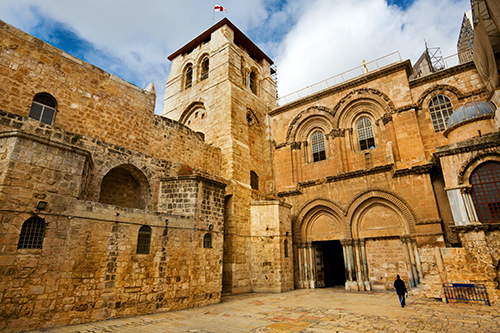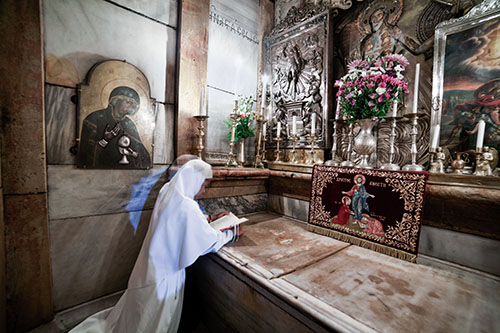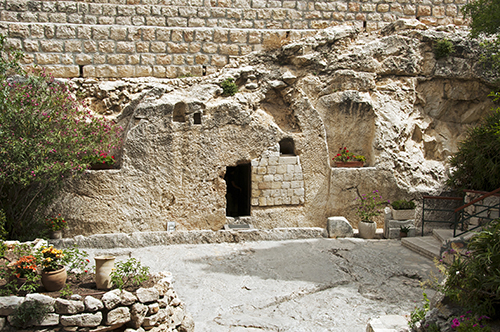

by Luke Chandler
Synopsis: Jesus’ death and resurrection are central to human history. Do we know the actual location of Golgotha? Tradition identifies two possible sites, but only one of them lines up with details provided in the Scriptures.
Do we know where Jesus was crucified and buried? Though we can never be 100% certain, archaeology and geography, combined with the biblical record, make a strong case for one location.
The Gospels provide details on the site of Jesus’ crucifixion and burial. It happened outside the city (John 19:20) at a place called Golgotha (Matt. 27:33-35; Mark 15:22-24; John 19:17-18). “Golgotha” is an Aramaic term that translates to “Place of a Skull” (“Calvary” in Latin). Scripture does not explain the reason for the name “Skull.” It may have described a rock formation that resembled a skull, or could just refer to a place commonly used for executions. The Gospels recall that Jesus was laid in a “new” tomb and was the first person to be buried there. His tomb was in a nearby garden and had a rolling stone-type entrance, which was typical of tombs during the Roman period (John 19:41-20:1; Matt. 27:59-60).
Two different sites in Jerusalem are linked with Jesus’ death and burial: The Garden Tomb, also known as Gordon’s Calvary, and the Church of the Holy Sepulchre. Only one of these locations matches the physical clues in the Bible and has been associated with Jesus since ancient times. Which site is it?
The Garden Tomb, located just north of the Old City walls, is peaceful and beautiful; an oasis of calm in modern Jerusalem. It looks and feels like a place we would associate with Jesus’ serene sacrifice. Modern caretakers maintain a garden atmosphere and provide quiet places for prayer and meditation. However, this is not the tomb for which we are looking. The design of the Garden Tomb is typical of the Divided Kingdom period and was already centuries old in Jesus’ time. It cannot be the “new” one described in the Gospels. The rolling stone visitors can see near the entrance today was brought over from a different tomb. The site feels genuine but does not match the Gospel description. We simply cannot associate it with Christ.
How did anyone come to link the Garden Tomb with Jesus? In 1842, scholar Otto Thenius suggested that a nearby eroded rock escarpment, which at the time resembled something like the face of a skull, could be Golgotha. In 1883, a British officer named Charles Gordon linked the nearby “Garden Tomb” to the skull-rock and popularized the notion it could have been Calvary. Despite no other evidence or previous tradition, Gordon’s proposal gained popularity, and the place became known as Gordon’s Calvary. Since Gordon and Thenius’ time, erosion has continued to re-shape the rock, and it no longer resembles a skull face, which raises the question of how skull-like it would have appeared eighteen centuries before.
In contrast, the Church of the Holy Sepulchre is a strong candidate for the site of Jesus’ crucifixion and burial. This location aligns with the physical descriptions in the Bible. In the early first century, the site was a disused quarry. A thirty-nine-foot mass of low-quality rock had been left in place, which may have given the appearance of a skull. (Alternatively, the term may simply have associated the spot with regular executions.) Archaeological excavations by Vergilio Corbo found dark, rich soil that is atypical of the Jerusalem area, which suggests that dirt was brought in to convert the quarry into a garden. The quarry/garden was outside the city walls in Jesus’ time but located near one of the gates, which fits the account of how Simon of Cyrene was easily pressed into service as he came in from the countryside (Matt. 7:39; Mark 15:1). Moreover, seven Roman period tombs have been identified on the grounds, showing it was an area used for burials.
Ancient memory also supports this identification as Golgotha. The early disciples knew exactly where Jesus had been killed and buried, and no doubt shared information on the location (as we can see in the Gospels). In the early second century, the Roman Emperor Hadrian filled in the area to create a massive earthen platform and built a temple to Aphrodite on top. By Constantine’s time, more than 200 years later, local memory still remembered the spot as the Golgotha, and the platform was excavated away to reveal the old rock and tombs from Jesus’ time. Constantine built a large church building on the site and named it Anastasia (“Resurrection”). Most of the building we see today dates to later periods, but still covers the same rock and tombs that early Christians associated with Jesus.
Today, the Holy Sepulchre Church is used by priests from several Orthodox churches and the Roman Catholic church. All groups claim ownership of different parts of the building and perform their own rituals at certain times. The result is a tense status quo that occasionally devolves into fistfights between clergy over perceived slights, or when someone acts out of turn. Visitors to the Holy Sepulchre will see countless religious icons displayed throughout, as well as worship rituals that descend from ancient paganism.
The Holy Sepulchre may be the actual location of Calvary, but it discouragingly symbolizes the division and apostasy that overtook the original church. Perhaps its greatest value is the reminder that Christians are the true Temple of the Lord. Jesus died near Jerusalem, but the Christ dwells today in the “living stones” of His holy, royal priesthood (1 Pet. 2:5, 9).
Author Bio: Luke has preached the Gospel for more than twenty years and currently works with the North Terrace congregation in the Tampa area. He has led tours and excavated in Israel for nine years. Luke and his wife Melanie have five children. He can be reached at lukechandler@verizon.net.


